Planning a trip to Yellowstone in the summer? The geysers, hot springs, forests, rolling hills, canyons, and wildlife will dazzle you in the best way!
Yellowstone is a huge National Park, and I think many first-time visitors really underestimate the size. If you don’t plan properly, you’ll spend a lot of time driving in and out of the park and between attractions.
It’s also one of the most popular National Parks. Yellowstone sees over 4 million visitors every year, and roughly 75% of them visit in the summer. It consistently ranks in the top 10 most visited National Parks in the US.
An enjoyable visit requires some planning and intentionality, especially if this is your first time visiting Yellowstone.
My husband and I visited Yellowstone during the summer of 2023, and I researched and planned our itinerary like crazy. Despite my efforts, there were still some things that surprised me and that I wish I knew ahead of time.
This post will cover 12 essential tips for visiting Yellowstone in the summer, including ways to beat the summer crowds and how to have the most enjoyable trip possible!
Basically this post is everything I wish I knew before visiting Yellowstone in the summer!
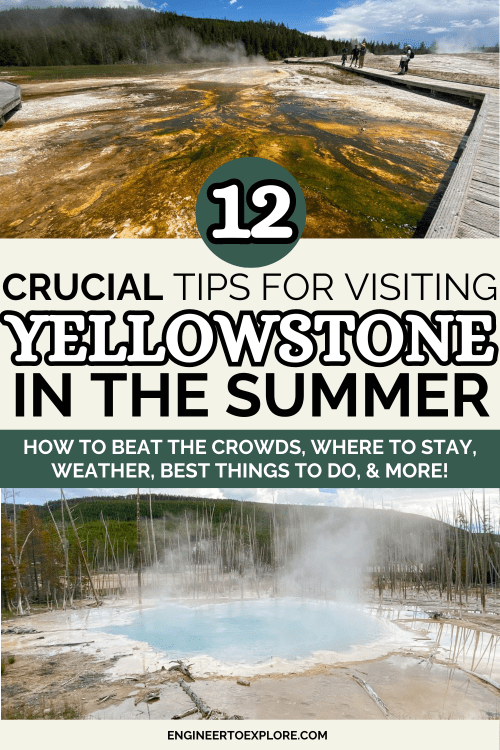
Is Yellowstone too Crowded in the Summer?
Yes, Yellowstone is crowded in the summer- there is no denying that. But most of the crowds are concentrated in a few areas, so there are ways to get off the beaten path and find solitude, even in the peak summer months.
Summer is your best option for visiting Yellowstone, especially if this is your first time and you want to experience everything. A lot of the park amenities and roads close down in the winter and the spring is really wet, muddy, and cold.
Summer will guarantee good weather and allow you to experience all that Yellowstone National Park has to offer.
If you’re really worried about the crowds, visiting in early September is a good option. July, August, and June are the busiest months, respectively. It will be a bit cooler in September, but kids are back in school and crowds are lower then!
Related: Visiting the Old Faithful Area of Yellowstone (How to Beat the Crowds, Tips, & More!)
What is the Weather Like at Yellowstone in the Summer?
The weather in Yellowstone in the summer is warm, but unpredictable. Most of Yellowstone National Park sits at an altitude of 7500 feet or higher, and weather gets more unpredictable the higher up you go.
Regardless, it will feel hot midday and chilly in the mornings and evenings since it’s a relatively dry climate.
We had short rain showers almost every day and even a hail storm one night!
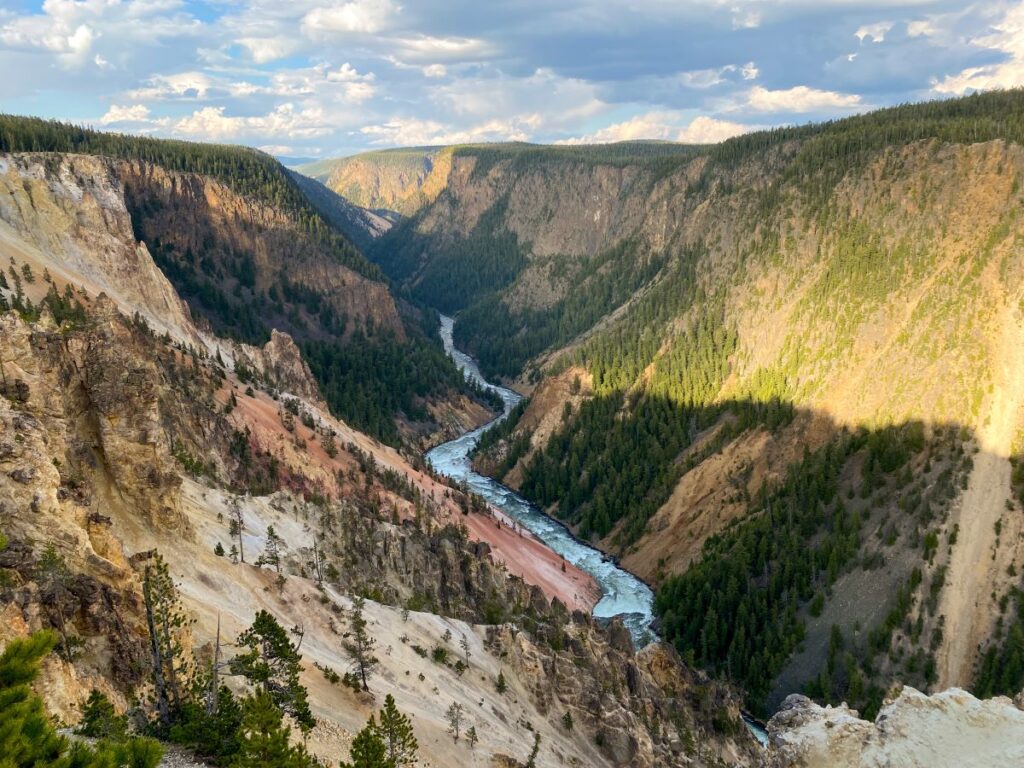
Yellowstone Attractions Map
The major attractions in Yellowstone are concentrated in a few areas. I’ve numbered them on the map below and have the attractions listed at each area.
- Mammoth Hot Springs (lodging and dining available)
- Lamar Valley
- Norris Geyser Basin, Artists Paint Pots
- Grand Canyon of the Yellowstone, Hayden Valley, Mud Volcano (lodging and dining available)
- Old Faithful, Upper Geyser Basin, Lower Geyser Basin, Midway Geyser Basin, Grand Prismatic Spring (lodging and dining available)
- West Thumb Geyser Basin (lodging and dining available)
There is lodging and dining in Mammoth, Tower-Roosevelt, Canyon Village, Old Faithful, Grant Village, and Lake Village.
Related: The Ultimate Yellowstone Bucket List: Top 17 Things to See & Do
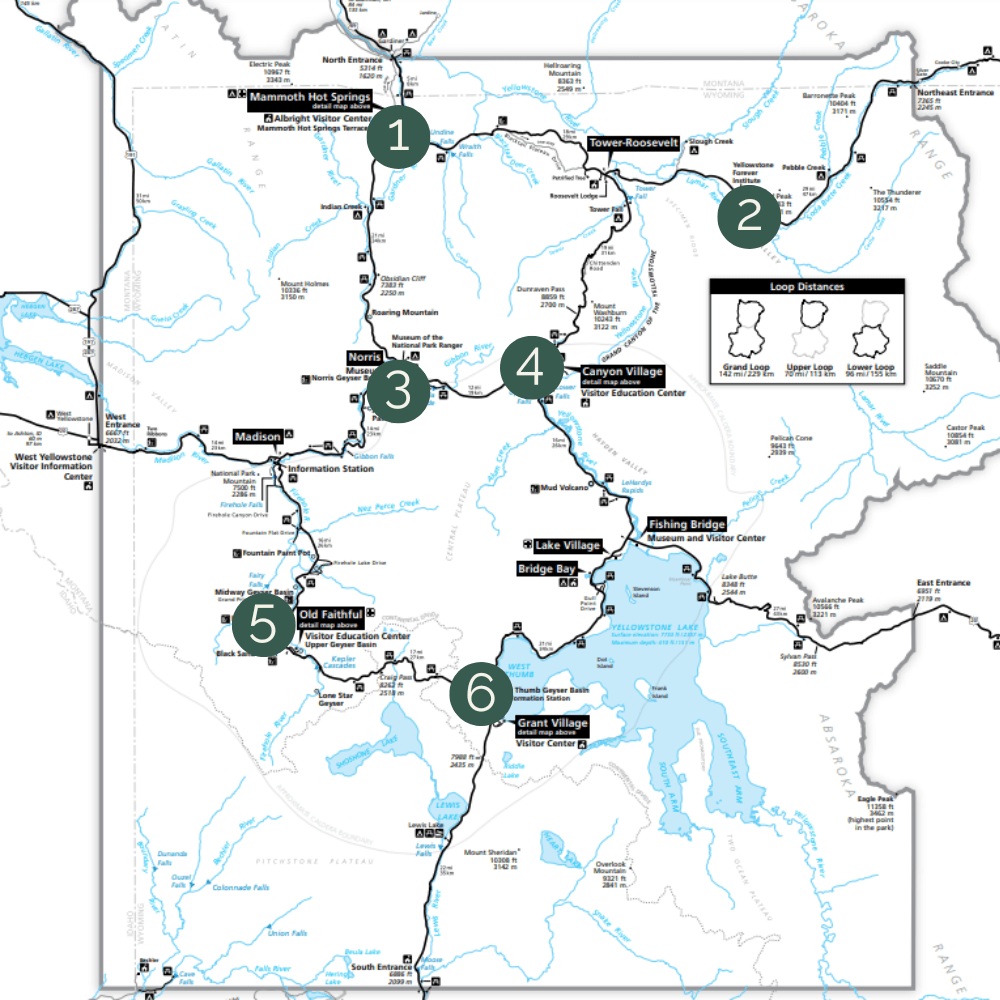
What to Pack for a Summer Trip to Yellowstone
America the Beautiful Pass: If you plan to visit 3 or more US National Parks that have entrance fees within one year, purchasing this pass will save you money. It’s $80 and gets you into over 2000 NPS-managed lands (including National Parks, Monuments, etc).
If you plan to visit Grand Teton and/or Glacier National Parks or Craters of the Moon National Monument on your trip, this pass will save you money!
Athleta Elation Leggings: I love hiking in leggings. These leggings from Athleta don’t fall down and have just a little bit of compression to hold you in without being uncomfortable.
Biker Shorts: Perfect for those warmer day hikes, biker shorts keep my thighs from chafing while also keeping me cool.
Athleta Conscious Crop Tank Top: These are my favorite tops to work out in, hike in, and do pretty much everything in. Great coverage, easy to layer, and they’re the perfect length to wear with high-waisted leggings or bike shorts.
Dry-Fit Hiking Tops: I like to bring a few different short and long-sleeve dry-fit tops to layer for hikes. The days will start out chilly and elevation changes can drastically change the ambient temperature.
Nalgene 32-oz Water Bottles: Cheap, lightweight, easy to clean, and hold a ton of water. I seriously never leave my house without one!
You won’t find me carrying a heavy, overpriced, stainless steel cup or a fancy water bottle with a mouthpiece that’s impossible to clean.
Merrell Moab 3 Hiking Shoes: I have had these shoes for over 4 years and I love them! They have great traction and are comfortable for long hikes at an affordable price point. Good shoes make a huge difference when you’re hiking, especially on muddy or rocky trails.
I sized down half a size from my normal size in these and still have plenty of room for good hiking socks. You don’t really need hiking shoes for most of the attractions at Yellowstone, but I found alternating regular tennis shoes and hiking shoes every other day helpful!
Smartwool Hiking Socks: I know these are pricey, but they are key to avoiding blisters when hiking and walking. Wool is naturally sweat and odor resistant so these socks will keep your feet cool and dry all day.
Hiking Day Pack: I have this cheap one from Amazon and it has worked great on all the short hikes I’ve done in the last 4 years! Instead of getting an expensive day pack, I would spend the money on this Osprey carry-on sized backpack to pack for an entire trip instead.
Sunscreen and Bug Spray: For obvious reasons.
Rain Jacket: It rained almost every day we were in Yellowstone!
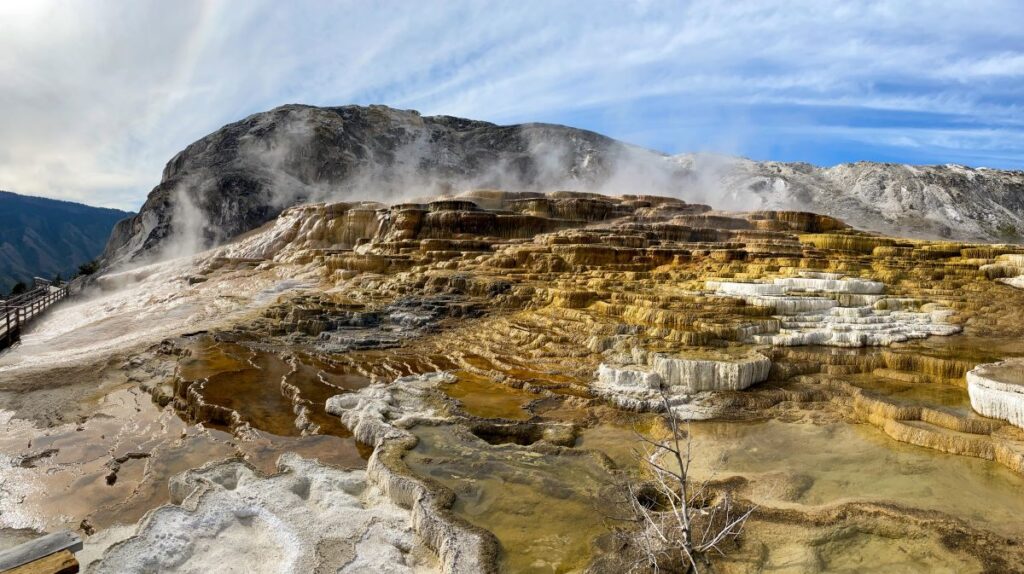
12 Tips for Visiting Yellowstone in the Summer
1. Book Your Trip for at Least 4 Days
Like I mentioned above, Yellowstone is a huge park! In order to have an enjoyable experience, plan to spend at least 4 full days here.
We spent 5 days/4 nights and saw all the highlights on the map and had time to rest. It really was the perfect amount of time.
You can see a lot in Yellowstone with less than 4 days, but you’ll probably feel rushed and miss out on some cool places. Save yourself the regret and give yourself plenty of time to enjoy your trip!
Related: The Ultimate 1-5 Day Yellowstone Itinerary
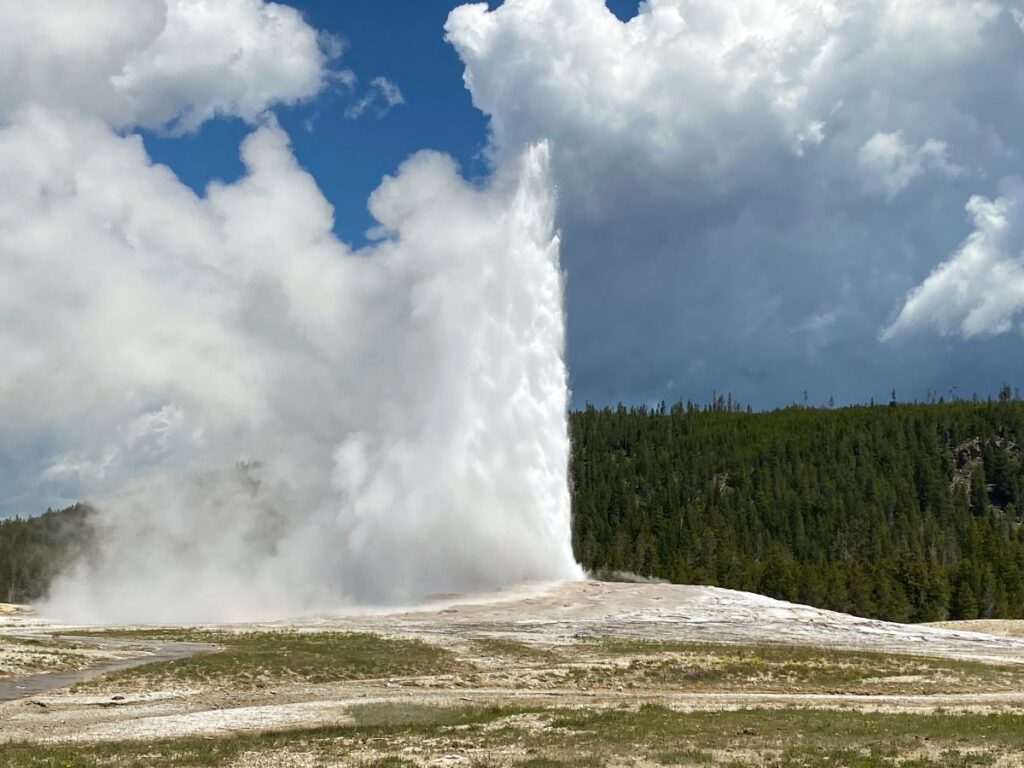
2. Be Prepared for a Lot of Walking
Most of the attractions in Yellowstone aren’t strenuous hikes per say, but there is a lot of walking involved, especially at most of the geyser basins.
You don’t really need hiking shoes for most of the highlights in Yellowstone, but sturdy walking shoes are a must. It’s even better if you can rotate between 2 pairs of shoes.
Upper Geyser Basin is almost 5 miles, Norris Geyser Basin is 3 miles, and the Grand Prismatic Spring Overlook is 1.5 miles (there are a lot of other places that are much shorter walks, but these 3 areas are just an example of how easy it is to overlook how much walking you’ll do!).
Stack 3-4 of these areas together in one day and you can easily do 10 miles of walking!
I recommend checking the length and elevation gain of each trail to make sure you’re planning a realistic itinerary for your fitness level and expectations.
I wrote a whole blog post ranking all 11 of Yellowstone’s geyser basins and list out the length, elevation gain, and time required to visit each one, so make sure to check that out when planning your itinerary!

3. Book Accommodations Inside the Park
A lot of National Parks have their own lodges inside the park grounds for convenience. I usually don’t recommend staying in these, since they can be very expensive and don’t offer many amenities.
However, Yellowstone National Park is one place where it 100% makes sense to pay for this convenience. Yes, it will be expensive, but it’s worth it, especially in the summer.
Depending on which entrance you’re staying at, the nearest town outside the park can be an hour or more away. This becomes problematic if you want to exit the park to relax in your hotel midday or come back after dinner.
Between 10 am and 3 pm, lines at the entrance gates can pile up and you do not want to be stuck waiting.
Plus, it’s really easy to get an early start if you can just walk outside of your hotel and be at Old Faithful or at the North Rim of the Grand Canyon of the Yellowstone instead of having to drive 30 minutes or an hour to the nearest attraction.
All of Yellowstone’s park lodges are managed by Xanterra. You can check dates and book your stay on their website here.
If you plan to visit Yellowstone in the summer, you’ll want to book your accommodations 6-12 months in advance because they sell out really quick!
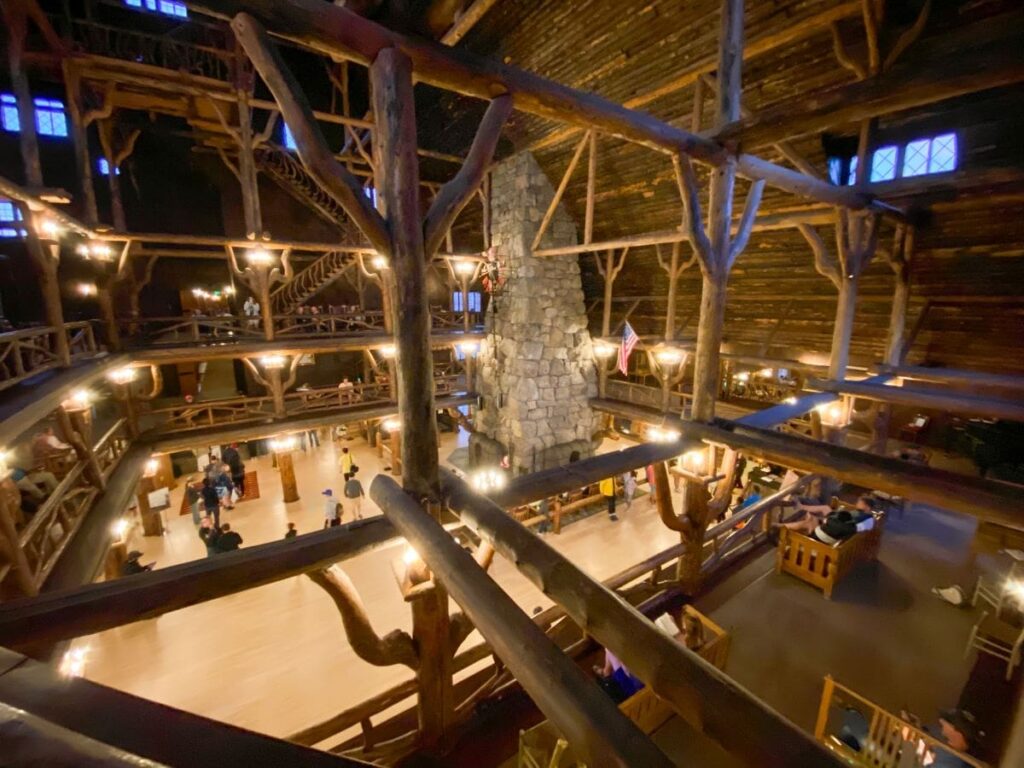
4. Stay in at Least 2 Different Areas of the Park
Similar to the point above, I highly recommend staying in at least 2 different areas of the park.
Yes, it is annoying to have to pack and unpack, but doing this will save you hours of driving time on your trip (Yellowstone is a freaking huge park).
We did 1 night in Gardiner (the only place I recommend staying outside the park near the north entrance- see my Yellowstone North Entrance Guide here), 2 nights in Canyon Lodge, and 1 night at the Old Faithful Inn.
If I could do it again, I would probably do 2 nights in Canyon Lodge and 2 nights in the Old Faithful Inn. Some of the lodges sell out quicker than others, so do your best to space yourself out during your stay based on availability.
Related: The Complete Guide to All 5 Yellowstone Entrances
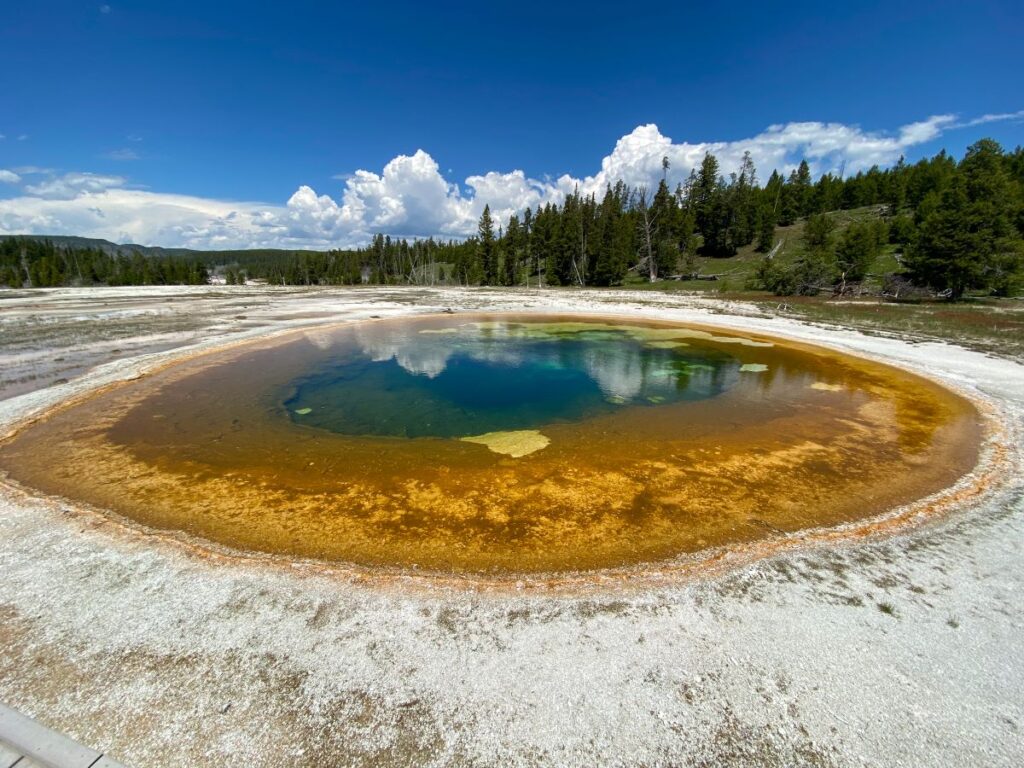
5. Wear Layers
The weather in Yellowstone in the summer is generally warm and nice, but still unpredictable. It’s best to pack layers and be prepared for any weather.
If it’s cloudy, it will be chilly. If it’s sunny, it will be hot. It also rained almost every day we were there.
I can’t tell you how many times I removed my long sleeve layer and put it back on throughout the day. I was very happy I dressed in layers so I was never too hot or too cold while out exploring!

6. Do Not Approach Wildlife
This should go without saying, but DO NOT APPROACH WILDLIFE. You’ve probably seen insane videos and photos of people approaching bison and other wildlife at Yellowstone National Park.
These animals are wild and unpredictable. It’s best to view them from a distance and/or in your vehicle. Please adhere to all park rules, despite what other “tourons” are doing!
Remember that you as a tourist are invading the homes of these animals. They were there first so please respect them by keeping your distance!

Be Bear Aware: If you plan to do any backcountry hikes, bring bear spray and know how to use it (you can buy it at any of the Yellowstone park stores). It is really unlikely that you’ll come across a bear, but take all precautions just in case. If you just plan to do the major attractions and stay on well-trafficked boardwalks, you won’t need bear spray.
7. Explore Mostly in the Mornings & Evenings
The biggest piece of advice I would give to anyone exploring Yellowstone in the summer is to do most of your adventuring in the morning and evening.
This is the best way to beat the crowds, enjoy cooler weather, and have an overall more peaceful experience. Get an early start, take a midday nap if you need to, and then go back out around 4 or 5:00.
You could also visit less popular places in the afternoon, or go for a hike. Most people in Yellowstone don’t get off the beaten path, so it’s possible to have an enjoyable hike midday.
Some of the less-populated areas in Yellowstone are:
- Blacktail Plateau Drive
- Artists Paint Pots
- Mud Volcano
- Monument Geyser Basin
- Lake Butte Overlook
- Lamar Valley
- Fairy Falls Trail
- Mt. Washburn
- Anywhere near Lake or West Thumb
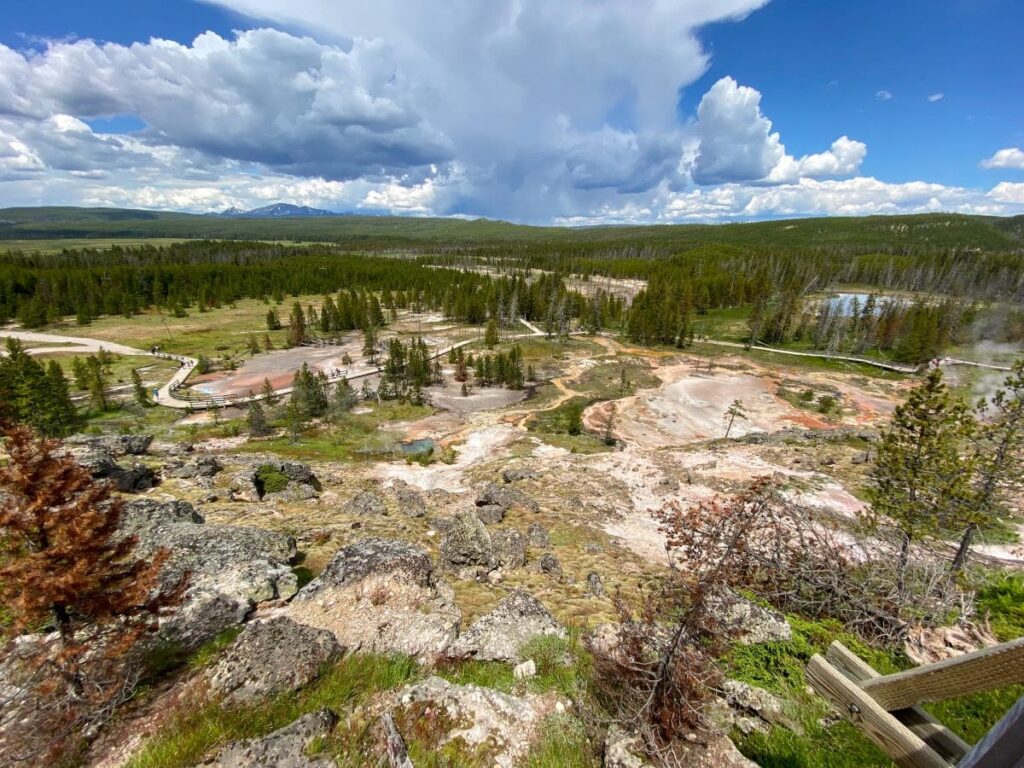
8. Visit Large Hot Springs in the Afternoon
I know this tip completely contradicts the above point, but the only exception to the morning and evening rule is for visiting large hot springs, specifically the Grand Prismatic Spring.
In the morning, the large hot springs are covered with steam so you can’t really see the bright colors before 11am. Wait until the midday sun is high enough to really make the colors pop.
Even though it will be crowded (especially at Midway Geyser Basin), bring your patience, don’t even try getting a parking spot in the lot (just park along the road and walk- trust me), and go midday.
Those colors are definitely worth it!
Related: All 11 Geyser Basins in Yellowstone Ranked
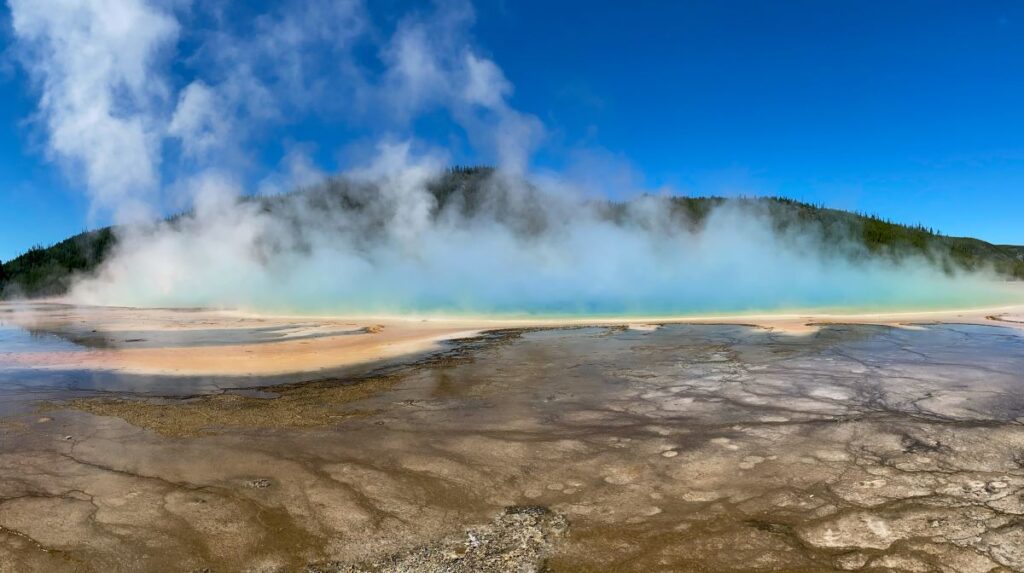

It is super important that you stay on the boardwalks when visiting geyser basins. These areas are very fragile and dangerous so staying on the boardwalks will protect you and the land.
9. Prepare for High Prices for Food & Accommodations
Because summer is peak season in Yellowstone, expect higher prices for food and accommodations.
We booked the cheapest rooms available and our average nightly stay was still over $300/night. Our room at the Old Faithful Inn didn’t even have a private bathroom!
A lot of the cheaper rooms get booked up very quickly, so I would recommend planning your trip around lodging availability well in advance.
Most of the food in Yellowstone is served cafeteria-style and is pretty basic. It’s not bad, but nothing great either. Again, you’re paying for convenience here because it is simply not practical to drive an hour or more outside the park to eat.
Expect to pay around $20 for a burger and fries. The fancier restaurants can be $40 or more per entree.
We didn’t come to Yellowstone for the food or fancy accommodations, but be prepared for these higher prices in the summer!
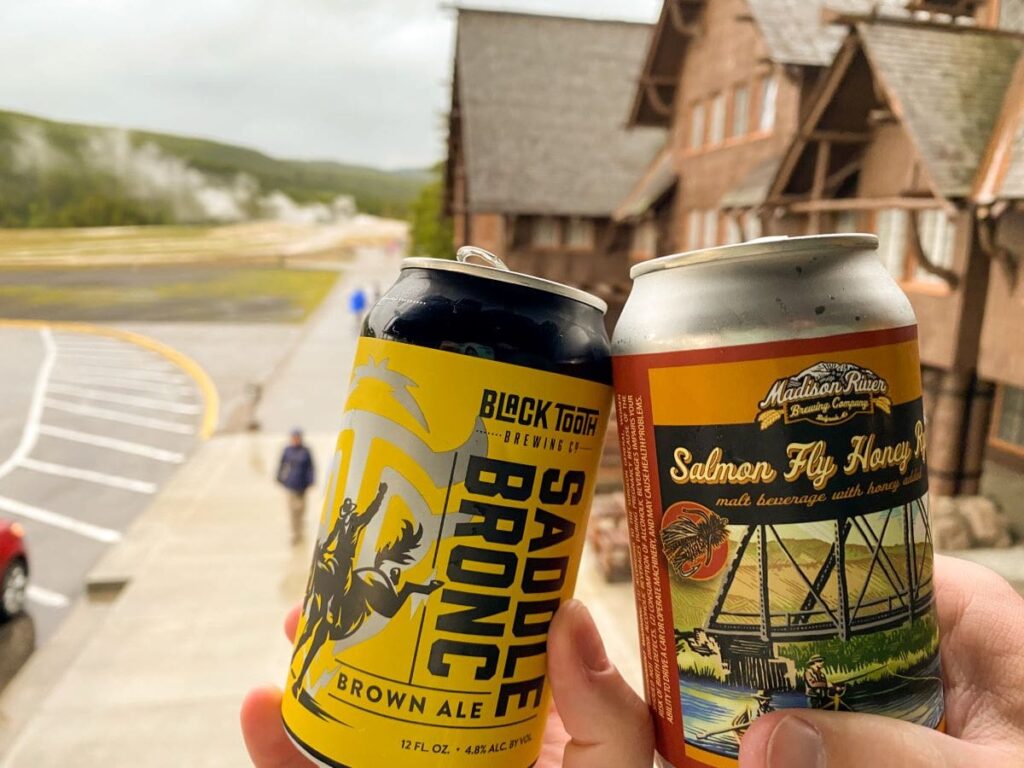
10. Early Morning & Evening are Best for Viewing Wildlife
The best time to view wildlife in Yellowstone is in the morning and evening.
Wildlife are most active at dawn and dusk. If you want the best chances of seeing bison, elk, bears, and other animals, plan a wildlife-viewing excursion early in the morning or in the evening.
The 2 most popular places to see wildlife in Yellowstone National Park are Hayden Valley and Lamar Valley.

11. Eat at Off-Peak Times or Pack a Picnic Lunch
Cafeterias and restaurants in Yellowstone during the summer can get really crowded at peak times, so it can be helpful to plan your meals at off-peak hours.
Since we did a lot of exploring early in the morning and evenings, we found an early lunch and dinner worked well.
You can also bring a cooler and pack a picnic lunch in your car and eat whenever you want!
12. Have a Game Plan, But Be Flexible
It will be hard to have an enjoyable trip to Yellowstone in the summer if you show up with no plan. The park is simply too huge and crowded to “wing it” and have an enjoyable experience, in my opinion.
It’s important to strategically plan which areas you plan to visit each day so you can minimize driving times and avoid the crowds at peak times.
I’m not saying you have to have every hour of every day planned, but knowing which attractions are closest to your hotel and assigning a few of them to each day will help tremendously!
While having a game plan is great, remember to be flexible as well. The changing weather will alter your plans and you might have to move things around in your itinerary. Yellowstone is also ever-changing, so some parts of the park might be closed with little to no notice.
For example, we originally planned to see the Grand Canyon of the Yellowstone in the morning, but it was so unbelievably foggy that you couldn’t see anything! So we went that evening instead.
We originally planned to do the Mammoth Hot Springs Terraces in the evening as we entered the park, but there was unexpected road construction on NE Entrance Road which delayed us. So we went first thing the next morning instead!
Create a well-planned itinerary for your trip to Yellowstone in the summer, but remember to leave some breathing room for unexpected weather, crowds, bison jams, or anything else that could change your plans.
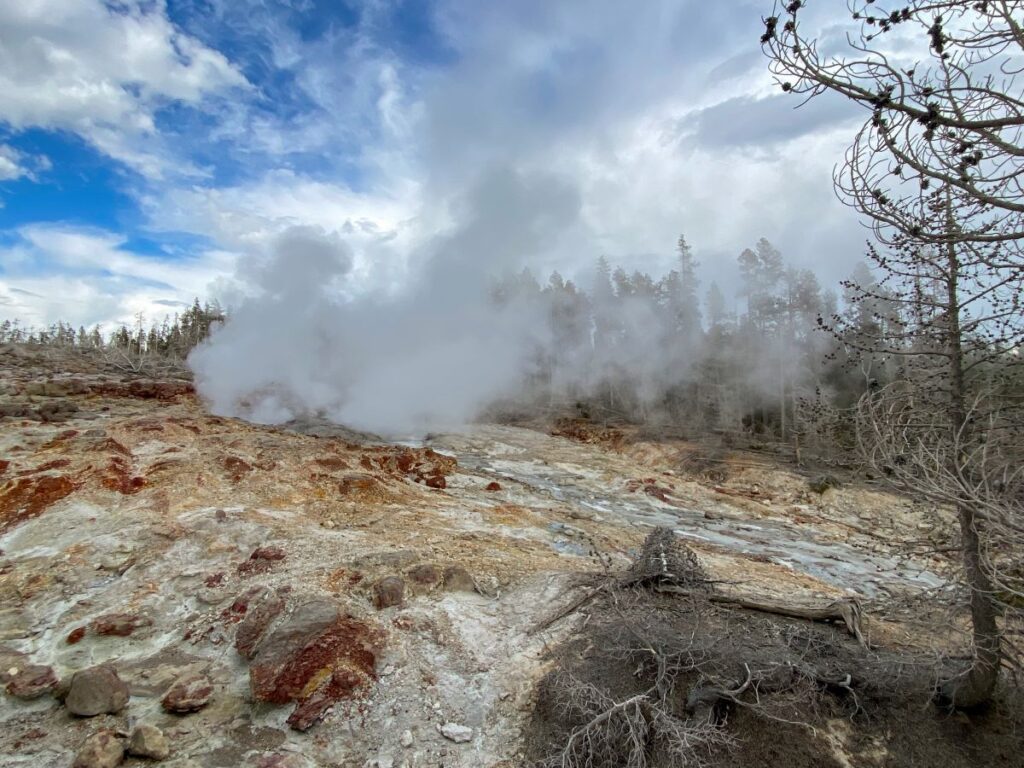
Visiting Yellowstone in the Summer FAQs
Is Yellowstone Busier in June or July?
Yellowstone is busier in July. July sees almost 950,000 visitors and June sees roughly 780,000.
How Warm is Yellowstone in the Summer?
Daytime temperatures in Yellowstone in the summer are usually between 70 and 80 degrees F.
In the sun, it will feel hot! When it’s cloudy, it will be chilly.
Is it Too Hot to Visit Yellowstone in July?
No, it is not too hot to visit Yellowstone in July. Even though July is the hottest month, temperatures rarely get above 80 degrees F. At higher elevations, it’s even cooler in the summer.
July is a very pleasant month to visit Yellowstone National Park!
How Do You Beat Summer Crowds in Yellowstone?
You can beat the summer crowds in Yellowstone by visiting popular destinations early in the morning and after dinner, going for a hike, and visiting less popular areas midday.
Avoid Old Faithful, Mammoth Hot Springs, and the Grand Canyon of the Yellowstone midday if you can.
Yellowstone is a huge park so it isn’t hard to get off the beaten path and away from the crowds if you are strategic with your time and are willing to hike and visit less popular attractions.
Crowds are inevitable in some places (Grand Prismatic Spring and Old Faithful), but your entire visit doesn’t have to feel like those areas.
What is the Best Month to Visit Yellowstone?
The best month to visit Yellowstone is in September. During late summer and early fall, the park will be fully open and you’ll avoid the peak summer crowds.
Having a pleasant visit in the summer is possible too, just bring your patience and prepare to get creative with your sightseeing!
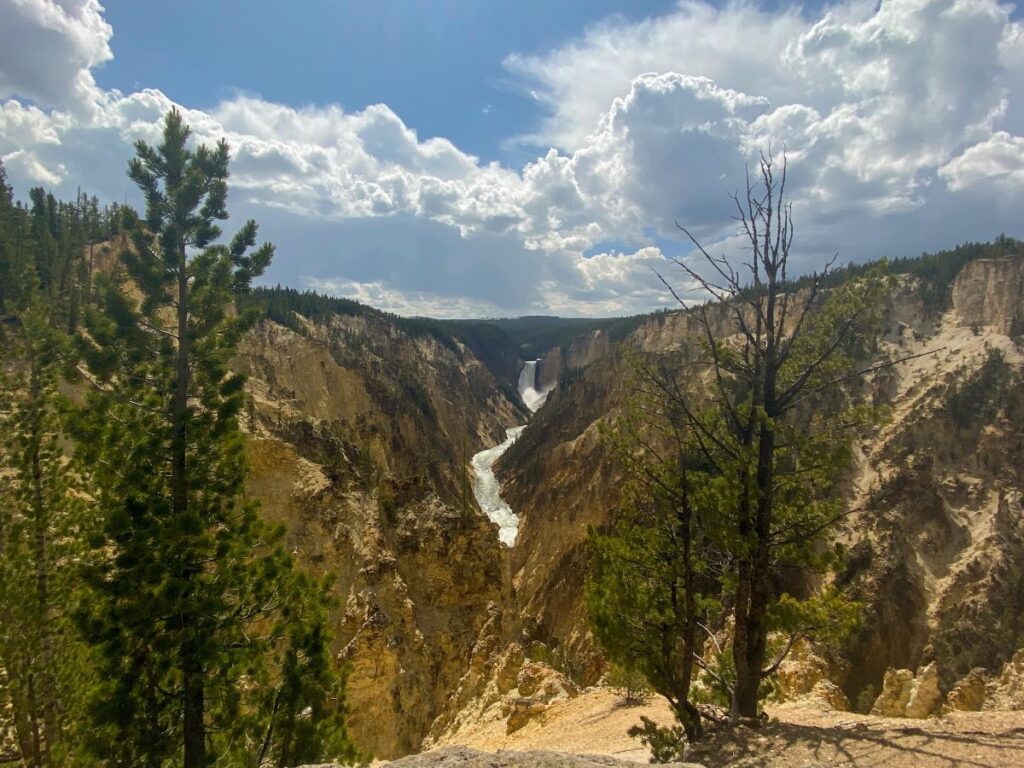
Was this post helpful when planning your trip to Yellowstone in the summer? Let me know in the comments below!
-Megan
More Information on Yellowstone National Park
Check out my other posts to help you plan your trip to Yellowstone National Park:
- The Ultimate 1-5 Day Yellowstone Itinerary
- Yellowstone in One Day: 7 Best Yellowstone Road Trip Itineraries
- The Ultimate Yellowstone Bucket List: Top 17 Things to See & Do
- The Ultimate 9-Day Yellowstone and Grand Teton Road Trip Itinerary (+ Maps, Photos, & More!)
- The Complete Guide to All 5 Yellowstone Entrances
- Visiting the Old Faithful Area of Yellowstone (How to Beat the Crowds, Tips, & More!)
- The Ultimate Guide to the Grand Canyon of the Yellowstone
- Yellowstone National Park North Entrance: A Complete Guide
- All 11 Geyser Basins in Yellowstone Ranked
- Beartooth Highway Scenic Drive Guide (With Tips & Photos!)


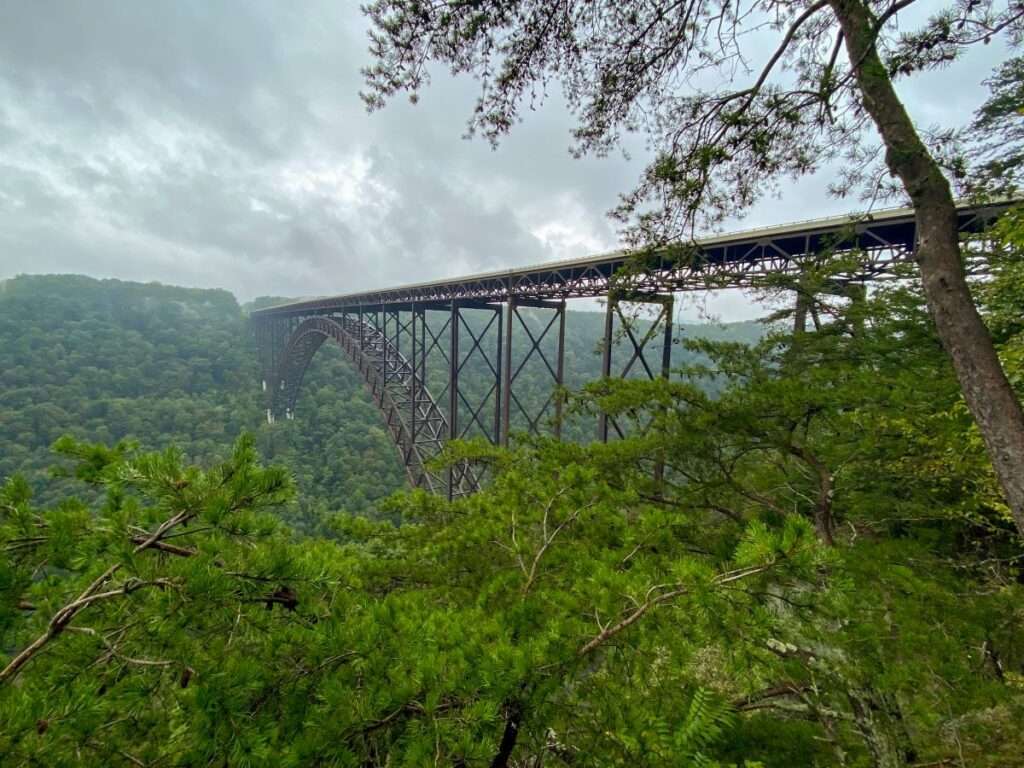
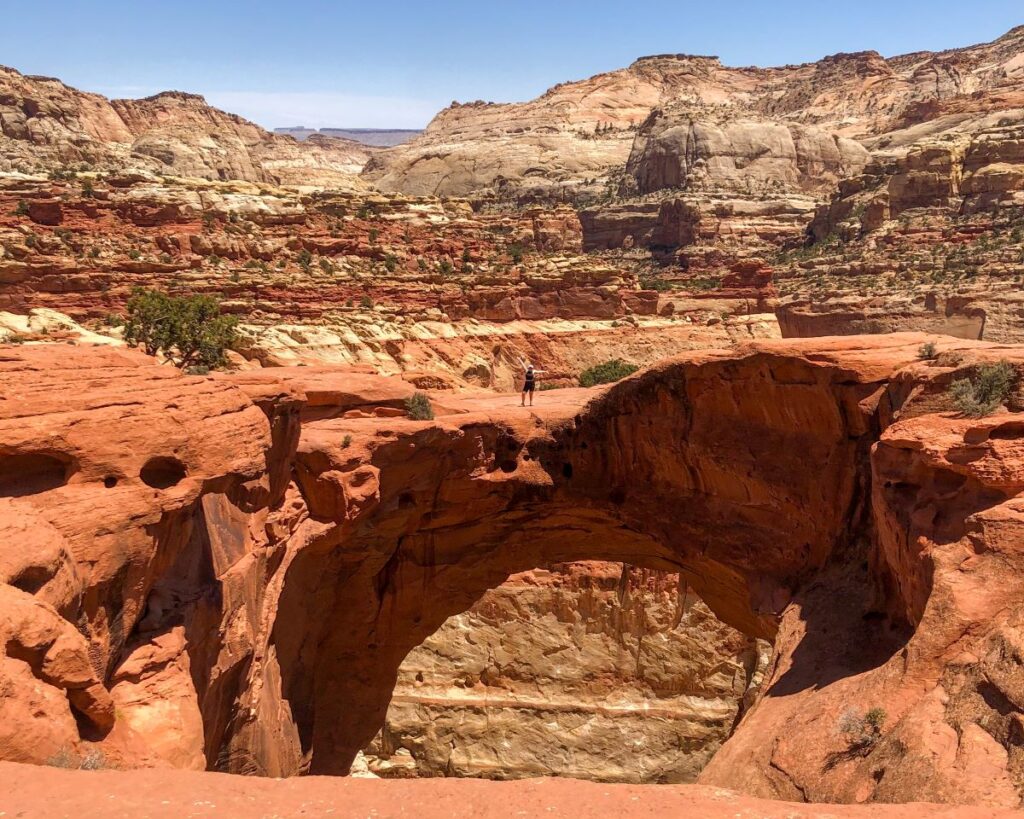
Pingback: Yellowstone in One Day: 7 Best Yellowstone Road Trip Itineraries - Engineer to Explore
Super informative and detailed so thank you from one planner to another!